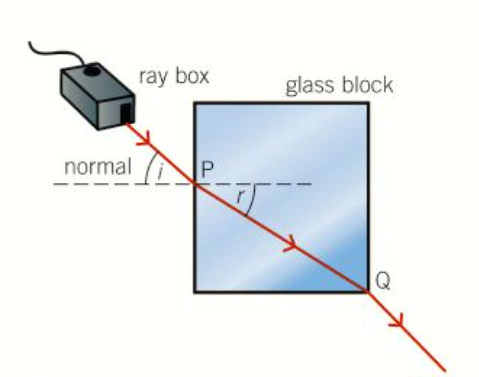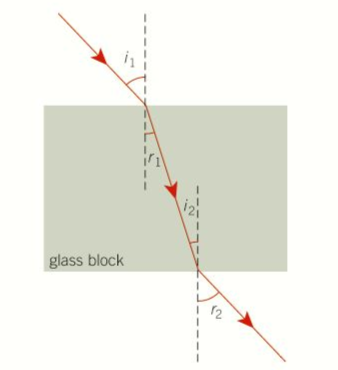5.1 REFRACTION OF LIGHT:
- Wave theory of light is used to explain the reflection and refraction of light.
- When the effect of lenses or mirrors on paths, we consider the drawing of diagrams using light rays and normals.
- Light rays represent the direction of travel of the waterfronts.
- And the normal is an imaginary line used to represent a perpendicular boundary to the two materials or a surface.
- Refraction is the change of direction which occurs when light passes at an angle across a boundary between two transparent substances.
- The diagram below represents this well:

- This diagram shows the change in the direction of a light ray from when it enters and leaves a rectangular glass block in air.
- The light ray bends:
- Towards the normal when it passes from air to glass
- Away from the normal when it passes from glass to air.
- Refraction cannot take place when the incident light ray is along the normal.
- At a boundary between two transparent substances, the light ray bends:
- Towards the normal if it pass into a more optically dense substance.
- Away from the normal if it passes into a less optically dense substance.
Investigating the refraction of light by glass:
- As shown in the figure above, the use of a ray box to direct a ray of light into a rectangular glass block at different angles of incidence at the midpoint P of one of the longer sides.
- The angle of incidence is the angle between the incident light ray and the normal between the point of incidence.
- The angle of refraction, r, at P is always less than the angle of incidence i:

- The ratio of
is the same for any light ray, this is also known as “Snell’s law”
For a light ray travelling from air into a transparent substance, the refractive index of the substance,
- Partial reflection also happens when a light ray in air enters glass.
Comparing glass to air refraction with air to glass refraction:
- In the diagram below, notice that the angle of refraction of the light ray emerging from the block is the same as angle of incidence of the light ray entering the block.
- Therefore: i(1) = r(2) AND i(2) =r(1)
- Therefore:
- AND:

5.2 MORE ABOUT REFRACTION:
Refraction occurs because the speed of the light waves changes in each substance.
- Amount of refraction that takes place depends on the speed of the waves in each substance.
Consider a wavefront of a light wave as it passes through a straight boundary from a vacuum into a transparent substance as shown below:
When the wavefront moves from XY to X’Y’ in time t, crossing the boundary between X and Y, in this time, the wavefront moves:
- A distance ct at speed c in a vacuum from Y-Y’
- A distance Cst at speed Cs in the substance from X-X’
Consider the triangle XYY’, as YY’ is the direction of the wavefront in the vacuum, and is therefore perpendicular to XY, then YY’= XY’Sin i, where i = angle YXY’
ct =XY’ sin i
Consider the triangle XX’Y’, as XX’ is the direction of the wavefront in the substance and is therefore perpendicular to X’Y’, then XX”= XY’Sin r, where r = angle XY’X’.
Therefore:
Therefore the refractive index of the substance:
- The smaller the speed of light is in a substance, the greater the refractive index of the substance.
- NOTE:
- The frequency of the waves do not change when refraction occurs, only speed and wavelength.
Refraction at a boundary between two transparent substances:
- Consider a light ray, crossing a boundary

